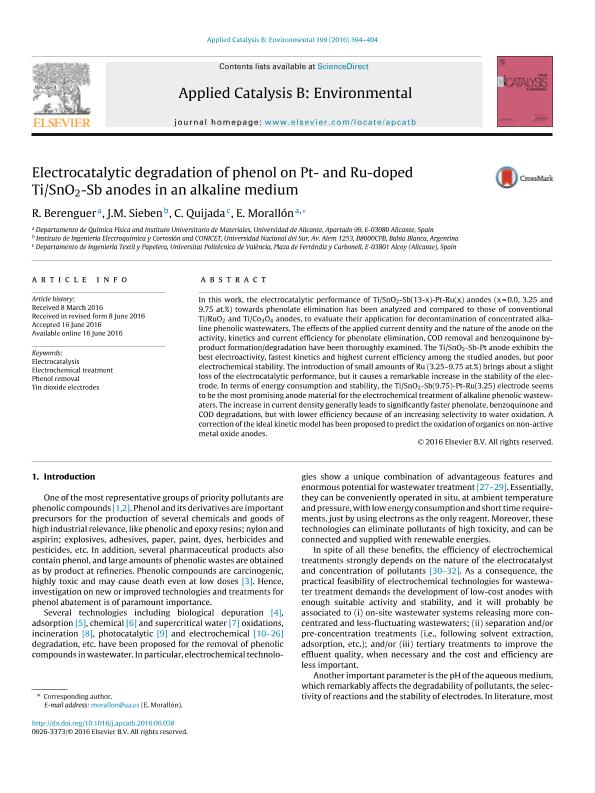Mostrar el registro sencillo del ítem
dc.contributor.author
Berenguer Rodríguez, José

dc.contributor.author
Sieben, Juan Manuel

dc.contributor.author
Quijada, C.
dc.contributor.author
Morallón, E.
dc.date.available
2018-06-12T19:04:21Z
dc.date.issued
2016-12-15
dc.identifier.citation
Berenguer Rodríguez, José; Sieben, Juan Manuel; Quijada, C.; Morallón, E.; Electrocatalytic degradation of phenol on Pt- and Ru-doped Ti/SnO2-Sb anodes in an alkaline medium; Elsevier Science; Applied Catalysis B: Environmental; 199; 15-12-2016; 394-404
dc.identifier.issn
0926-3373
dc.identifier.uri
http://hdl.handle.net/11336/48404
dc.description.abstract
In this work, the electrocatalytic performance of Ti/SnO2-Sb(13-x)-Pt-Ru(x) anodes (x = 0.0, 3.25 and 9.75 at.%) towards phenolate elimination has been analyzed and compared to those of conventional Ti/RuO2 and Ti/Co3O4 anodes, to evaluate their application for decontamination of concentrated alkaline phenolic wastewaters. The effects of the applied current density and the nature of the anode on the activity, kinetics and current efficiency for phenolate elimination, COD removal and benzoquinone by-product formation/degradation have been thoroughly examined. The Ti/SnO2-Sb-Pt anode exhibits the best electroactivity, fastest kinetics and highest current efficiency among the studied anodes, but poor electrochemical stability. The introduction of small amounts of Ru (3.25?9.75 at.%) brings about a slight loss of the electrocatalyticperformance, but it causes a remarkable increase in the stability of the electrode. In terms of energy consumption and stability, the Ti/SnO2-Sb(9.75)-Pt-Ru(3.25) electrode seems to be the most promising anode material for the electrochemical treatment of alkaline phenolic wastewaters. The increase in current density generally leads to significantly faster phenolate, benzoquinone and COD degradations, but with lower efficiency because of an increasing selectivity to water oxidation. A correction of the ideal kinetic model has been proposed to predict the oxidation of organics on non-active metal oxide anodes.
dc.format
application/pdf
dc.language.iso
eng
dc.publisher
Elsevier Science

dc.rights
info:eu-repo/semantics/openAccess
dc.rights.uri
https://creativecommons.org/licenses/by-nc-sa/2.5/ar/
dc.subject
Electrocatalysis
dc.subject
Electrochemical Treatment
dc.subject
Phenol Removal
dc.subject
Tin Dioxide Electrodes
dc.subject.classification
Otras Ciencias Químicas

dc.subject.classification
Ciencias Químicas

dc.subject.classification
CIENCIAS NATURALES Y EXACTAS

dc.title
Electrocatalytic degradation of phenol on Pt- and Ru-doped Ti/SnO2-Sb anodes in an alkaline medium
dc.type
info:eu-repo/semantics/article
dc.type
info:ar-repo/semantics/artículo
dc.type
info:eu-repo/semantics/publishedVersion
dc.date.updated
2018-06-07T16:12:15Z
dc.journal.volume
199
dc.journal.pagination
394-404
dc.journal.pais
Países Bajos

dc.journal.ciudad
Amsterdam
dc.description.fil
Fil: Berenguer Rodríguez, José. Universidad de Alicante; España
dc.description.fil
Fil: Sieben, Juan Manuel. Consejo Nacional de Investigaciones Científicas y Técnicas. Centro Científico Tecnológico Conicet - Bahía Blanca; Argentina. Universidad Nacional del Sur. Departamento de Ingeniería Química. Instituto de Ingeniería Electroquímica y Corrosión; Argentina
dc.description.fil
Fil: Quijada, C.. Universidad Politécnica de Valencia; España
dc.description.fil
Fil: Morallón, E.. Universidad de Alicante; España
dc.journal.title
Applied Catalysis B: Environmental

dc.relation.alternativeid
info:eu-repo/semantics/altIdentifier/doi/http://dx.doi.org/10.1016/j.apcatb.2016.06.038
dc.relation.alternativeid
info:eu-repo/semantics/altIdentifier/url/https://www.sciencedirect.com/science/article/pii/S0926337316304763
Archivos asociados
